- What is an Insecticidal Soap?
Insecticidal soap a.k.a soap salts, is an organic pesticide made of potassium salts of fatty acids and is derived from plant oils like coconut oil, olive oil, etc.
The difference between soap salts and regular soap is the alkali used in making this. In bar soap, they use sodium hydroxide, whereas in insecticidal soap they use potassium hydroxide to make potassium salts of long chain fatty acids which are considered safe, non-toxic and eco-friendly and infact approved for use as an organic pesticide. As always, we always recommend you not to use hazardous chemical fertilizers and pesticides in our website.
PURCHASE LINKS:
Insecticidal Soap (Potassium Soap Salt) Concentrate: https://amzn.to/3vBBzzk
GardenSafe Ready to Spray Insecticidal Soap: https://amzn.to/3hD9MWV
- What is the mechanism of Action of Insecticidal Soap Spray?
Insecticidal soap acts by contact. It kills insects in three ways:
- It damages their cell membranes, causing the contents of the cell to leak out, leading to dehydration and death.
- It melts the protective wax that covers certain insects (mealybugs and other scale insects) and this leads to dehydration from evaporation.
- It blocks the pores through which insects breathe, leading to asphyxiation and death.
The pest treated usually dies very rapidly, within minutes of treatment.
- What are the insects and pests that are sensitive to Insecticidal Soap Spray?
Insecticidal soap is most effective on soft-bodied arthropods, a group that includes most plant pests like Aphids, Earwigs, Leafhoppers, Mealybugs, Sawfly larvae, Spider, mites, Thrips, Whiteflies and even Small caterpillars. Apart from these, insecticidal spray is also recommended and very effective for treating powdery mildew disease. Identify Various Pests here!
- What are the insects that are not harmed by Insecticidal Soap?
Normally, the pollinator insects like bees, butterflies, ladybugs, lacewings, etc. are not harmed by insecticidal soap.
- Ready to Buy Formulations of Insecticidal Soap:
You have two options to choose. One is Ready-to-use insecticidal soap spray that comes packaged in a spray bottle. The second option is to buy a concentrated solution. You have use some 5ml per liter of water and then spray on your plants. Many gardeners like the idea of the ready-to-use product because it’s already mixed in the correct proportions so there’s very little risk of plant damage. The bottle may be labeled as “Suitable for Organic Use,” or “Safer for Plants and Vegetables,” but if it is a true insecticidal soap, its bottle will list “potassium salts of fatty acids” as ingredients. Please check this composition before purchase.
PURCHASE LINKS:
Insecticidal Soap (Potassium Soap Salt) Concentrate: https://amzn.to/3vBBzzk
GardenSafe Ready to Spray Insecticidal Soap: https://amzn.to/3hD9MWV
- How to use these Insecticidal Soap Sprays?
Before we go to making your own powerful insecticidal spray, let’s learn how to use these commercial formulations. The ready to spray bottle is simple to use. Just shake well before use and start spraying thoroughly on the affected areas of your plant. If you have the concentrated solution of the insecticidal spray, use 5ml per liter of water or as directed in the bottle usage instructions. Mix well and spray the plant thoroughly or wet the plant completely, because It is effective only when it is wet and has no residual effect. In other words, it loses all its effect once it dries out. But the pests usually die very rapidly, within minutes of treatment. You may also perform a patch test before using it for the first time. We will discuss about it later.
- DIY Powerful Pesticide Recipe:
The active ingredient in insecticidal soap is the soap, itself. While many homemade recipes may tell you to add additional stuff, such as garlic, chili powder, etc, the insecticidal soap is actually the main ingredient. We will make the recipe for 1 liter of water in this demonstration.
- Take 1 liter of water in a container which can be closed (Distilled water is best. Do not use hard water)
- Add 1 full teaspoon of mild liquid soap – like hand wash liquid. Do not use stronger ones like dish wash soap. Liquid soaps contain potassium salts of fatty acids which are soap salts.
- Add 1 full teaspoon of vegetable oil like coconut oil to this. Now this will be your home made insecticidal spray. But to add more power to this, you need to add Neem oil to it, like about 5 ml, especially if the pests infestation is too extensive or resistant to any of the treatments.
- Mix it well by closing the cap and shaking it well for few minutes.
- Fill your spray bottle and shake every time before you spray.
- Both the liquid soap and the oil act as surfactants to help keep the solution from quickly running off the plant’s leaves when sprayed. The longer the solution remains on the plant’s foliage, the better the chance of killing the pests.
- What is Patch Test?
Whenever you make or use a pesticide for the first time, always do a patch test on a leaf first before spraying on the entire plant. You never know, how strong it is and may damage your plant. So, first spray it on a leaf or branch and wait for 1 or 2 hours. If the leaves start wilting, then its too strong to use. Dilute it accordingly and use.
- How often Should I spray?
For pest prevention, spray plants thoroughly with insecticidal soap once in 10 – 15 days. For treatment once weekly or max twice weekly. And after a heavy rain, you have to reapply the spray.
- Can I store this solution once prepared?
You can refrigerate it to store. But always better to make fresh solution every week.
PURCHASE LINKS:
Insecticidal Soap (Potassium Soap Salt) Concentrate: https://amzn.to/3vBBzzk
GardenSafe Ready to Spray Insecticidal Soap: https://amzn.to/3hD9MWV
First and foremost, please avoid the use of chemical pesticides and fertilizers which have a lot of hazardous effects on humans and animals. That’s the main reason, why we promote the use of natural agents in this gardening portal.
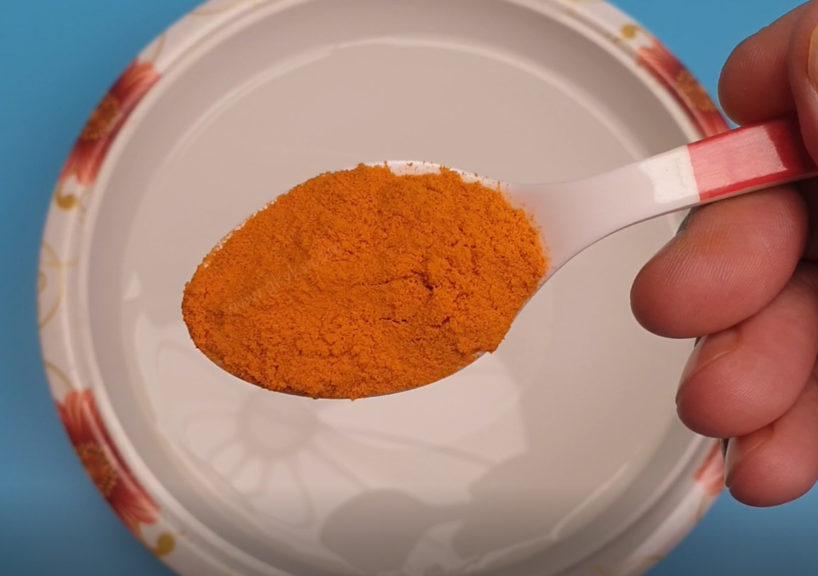
Turmeric rhizome contains a substance called Curcumin, which is a very potent antioxidant, has antimicrobial, anti-inflammatory, hepatoprotective effects, and it is very beneficial in boosting the immune system of our body. Turmeric is not only good for the human body but also has some amazing benefits in the garden. You can easily grow turmeric plant from a small piece of turmeric rhizome and harvest a lot of turmeric.
- ANT REPELLANT: Sometimes Ants, especially if there are lots of them, can be a menace to your garden. They seem to be particularly sensitive to turmeric’s strong odor.
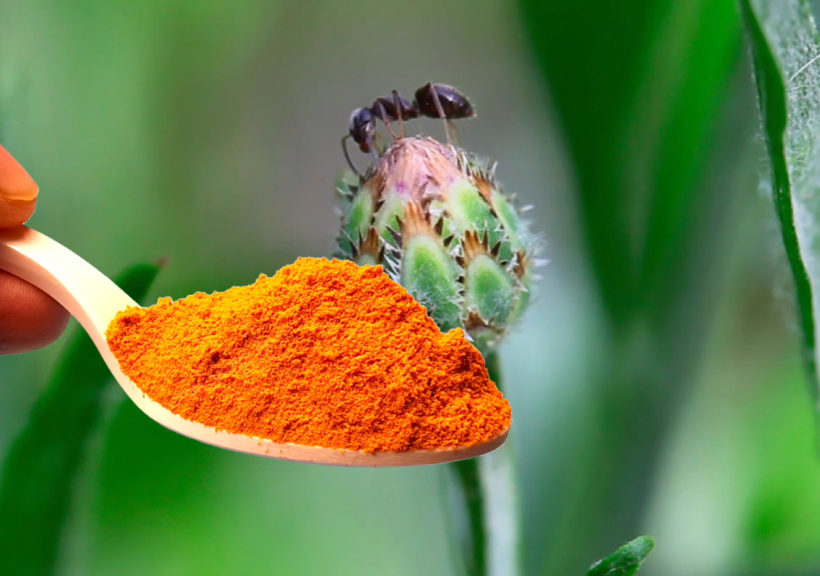
- How to Use Turmeric to Get rid of Ants? Simply sprinkle turmeric powder around your plants and even over the surface of the soil. Just few pinches and not too much. This can repel ants and help you get rid of these unwanted visitors in your garden, which can sometimes pose a serious threat by carrying mealybugs to the growing ends of plants. Yes! Mealybugs and ants have a symbiotic relationship. Ants carry mealybugs to growing ends of plants in exchange for the honeydew excreted out of their anus. So, Ant control means mealybug control.
- SOIL PEST CONTROL: You can get rid of soil pests particularly fungal root rot and fungus gnats in the soil by mixing turmeric in soil. You can mix about 1 tablespoon per gallon of soil while making your potting mix or whenever you repot your plant. Remember, adding too much of it can have negative impact on the beneficial soil microbes. The other method to use for plants that cannot be repotted, is mixing 1 tablespoon of turmeric in 1 gallon of water or 1 teaspoon per liter of water and thoroughly water your affected plant with this solution. We will shortly discuss on how to make a powerful pesticide spray using turmeric. Please watch it till the end.
- HEALING TREE WOUNDS: Similar to humans, open wounds or injuries in plants, can make them susceptible to different kinds of diseases and infections, particularly fungal rot. Due to its natural antiseptic and antibacterial properties, turmeric is also a natural remedy to heal various types of plant wounds. You can make a turmeric paste and apply over the wound to save the plant. This also helps in plant stem or branch fractures. You apply the paste and tie a polythene or grafting tape to save the plant. This turmeric treatment is also commonly used after pruning tree branches to cut wounds, also used in grafting, and any other similar situations when the plant becomes exposed to external damaging factors.
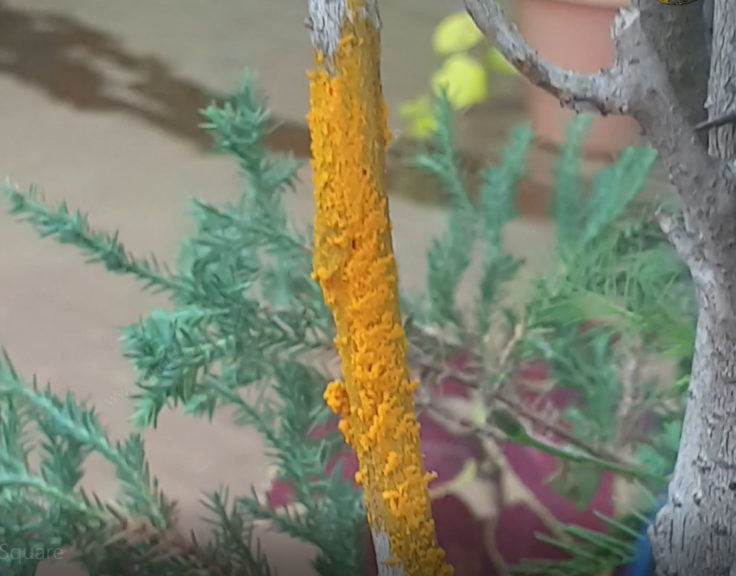
- TO TREAT ROSE DIE BACK DISEASE: Rose dieback is a condition commonly affecting rose plants where there is browning or blackening of the tip of the rose stem or a branch which then travels down toward the graft and may engulf the whole plant causing death. It can either be a Branch die back or the main stem dieback towards the graft. It is in fact a commonly encountered problem by every gardener and can sometimes be too bad causing death of the plant if no intervention is done. Though, the main treatment of Dieback disease is pruning the involved stem or branch, applying turmeric paste over the wound after pruning helps prevent progression of Rose dieback disease.
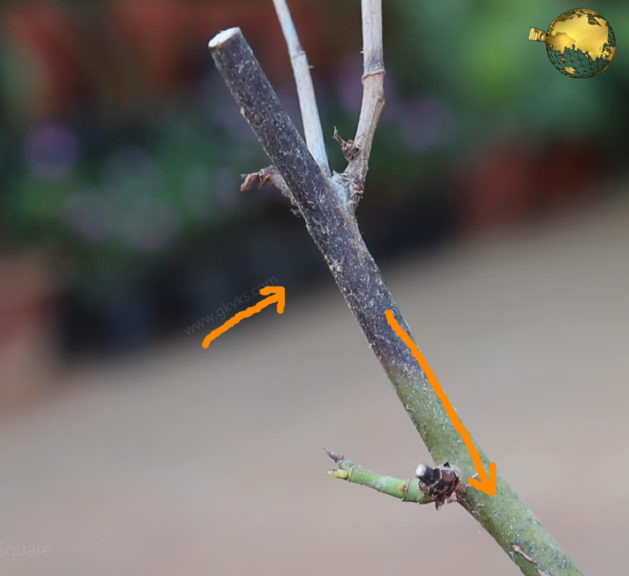
- AS A ROOTING AGENT: Though not a rooting hormone, turmeric can be used to increase the chances of rooting plant cuttings. This is mainly because of its anti-microbial and anti-fungal effects.
- PESTICIDE SPRAY: Turmeric alone as a spray can be used to treat few fungal plant diseases and pests like powdery mildew and other fungal spots. But it is not effective against pests like mealybugs, aphids, mites and other pests. For minor fungal spots and powdery mildew, you can mix 2 tea spoons of turmeric powder in 1 litre of water and spray on the affected plant.
Though there is no substitute to neem oil for pest control, you can make a powerful and broad-spectrum pesticide using turmeric and other stuff, especially if neem oil is not available in your location. You need to mix other stuff depending on what you want to treat.
- For Powdery mildew, you can mix 2 teaspoon of Turmeric powder, 100 ml of milk and 2 teaspoons of distilled white vinegar to 1 litre of water and spray on the affected plant. This is the most powerful natural remedy to treat powdery mildew.
- If Neem Oil is not Working on Certain Pests: You can add Turmeric and Garlic to neem oil solution if the pests are resistant to neem oil. You mix 5 to 10 ml neem oil in 1 litre of water and add 1 – 2 teaspoons of turmeric powder or even fresh turmeric rhizome and then add 4 to 5 cloves of crushed garlic to this mixture and sieve it fine to avoid clogging of spray bottle. Spray this once weekly. Patch test on a leaf may be important, depending on the concentration of your neem oil brand.
Have you noticed, how plants suddenly look greener during rainy season? One of the reasons is hydrogen peroxide found in small amounts naturally in rain water.
Although Hydrogen Peroxide is a chemical, but it easily decomposes to water and oxygen, and hence safe to be used even in organic gardening in varying dilutions. It is a colourless and odourless liquid and a commonly used medical and household disinfectant.
Now, the Concept for using Hydrogen peroxide in garden: It has a chemical formula H2O2 similar to that of water, but with an extra oxygen atom. This concept of additional oxygen release when hydrogen peroxide breaks down is the key to its beneficial effects in gardening.
Well, before we list out the top 10 benefits of hydro gen peroxide in garden, you must be aware of what concentration to purchase from the medical stores. It’s very inexpensive and commonly available in 3%, 6% and sometimes 35%. We will be using 3% or 6% hydrogen peroxide in our garden. Please watch this video till the end!
10. Save a Dying Plant: Applying the concept of extra oxygen atom release, we can revive a dying plant with hydrogen peroxide. First Check by scratching the stem, if its green and juicy, then it can be revived. Cut off all the dead branches and stem till the viability zone or the green zone. Take out the plant by its roots. Inspect the roots for any rot. Prepare a diluted hydrogen peroxide solution using 3% or 6%. Use 2-3 teaspoons of 3% peroxide per litre or 2 tablespoons per gallon of water. If you are using 6%, the dosage is half of this. Now soak the roots into this solution for about 6 hours. Then repot this in a clean fresh potting mix and new container. Water this with the same solution and leave it alone in shade for few days. Water the plant only when 1 or 2 inches of top soil dries out completely. You can repeat watering with this solution till it begins to show signs of life.
9. Accelerate Seed Germination: Seeds soaked in diluted hydrogen peroxide germinate faster and display healthy growth in future. Since the oxygen requirement of sprouting seeds is very high, this extra oxygen supply is obviously beneficial. You can soak seeds in a solution with 1-2 teaspoons of 3% peroxide per litre of water or water the seedling tray of seeds are already planted. This also takes care of any seed borne pathogens and helps in better root development of the seedlings.
8. Disinfecting Garden tools: especially the cutting and pruning tools should be disinfected while taking plant cuttings for rooting or cloning your plants. You can use 6% h2o2 solution to wipe off the cutting tool with a cotton or dip the tool into the solution for few minutes. This increases the chances of a high success rate in growing plants from cuttings.
7. Disinfect Seed Germination Trays: for a high success rate in germination your seed trays have to be free from pathogenic microorganisms. You can wipe them with 6% solution without any dilution.
6. Treat Fungal or Bacterial Root Rot: Overwatering can cause a shortage of oxygen at the roots. By filling the air pockets found in the soil around your plants, suffocating the roots of the plant. This lack of air causes the plants to start dying due to root rot. To treat this problem, you can water them with a mixture of two to three teaspoons of 3 percent hydrogen peroxide per litre of water or 2 tablespoons per gallon of water. The extra oxygen found in the hydrogen peroxide delivers the much-needed oxygen to the plant’s roots. After applying this solution to your plants avoid watering again until the top two inches of the soil is completely dried.
5. To Sterilize the Seed Starting Mix for better success in seed germinations. Add a 1:3 dilution of 3% h2o2 in water to the seed starting mix and leave it over night before using the soil or mix for seed sowing. You can also sprinkle this on your potting mix to disinfect your potting soil.
4. Weed Killer: At 10% or higher concentration of hydrogen peroxide, it completely destroys all types of vegetation it comes in contact with. But use it with caution around your plants. This is best applicable for cracks and crevices.
3. As a Fertilizer: Water your plants with a very dilute solution of hydrogen peroxide once in a month for the rain effect. You can add 1 teaspoon per litre of 3% hydrogen peroxide or 1 table spoon per gallon of water and water your plants to supply oxygen to the roots.
2. In hydroponic or aquaponics system: the addition of hydrogen peroxide to the water will keep the plants healthy. The roots of plants, as well as the aquatic life, appreciate the extra supply of oxygen.
1. EFFECTIVE PESTICIDE AND ANTI FUNGAL: It can control many common pests and insects in garden, mainly the sap sucking pests like aphids, mites and mealybugs. It can kill the eggs and larvae of moths and other harmful pests with its strong oxidizing effect. To make this pesticide, use 1 cup that’s about 250 ml of 6% hydrogen peroxide per litre of water or 2 cups of 3% h2o2 per litre of water. Load it in a spray bottle and spray on the plants. To control Fungus gnats and soil pests, you can water the plant with the same solution. It can also used in the treatment of mold and powdery mildew fungus.
Technically, Aspirin is not an organic solution, however, it is a safe and very inexpensive option that contains far fewer chemicals than the store-bought chemical products for gardening. I think most of us might have exhausted their regular pesticide stocks during this lockdown period, especially the great neem oil. Do not worry and watch this video till the end.
Aspirin is chemically Acetyl Salicylic Acid and medically a non-steroidal analgesic and anti-inflammatory medicine, inexpensive and easily available in almost all medical stores.
So, what is the actual concept behind using Aspirin in gardening and farming. Salicylic acid is naturally found in willow bark and many other trees. Studies have found that the plant hormone salicylic acid is released in tiny amounts when plants are in stress. So this concept has been utilized and many benefits of Aspirin have already been proven. Here we are using Aspirin 350 mg dispersible tablet – brand names like Disprin, Ecospirin, Bayer Aspirin and so on. If you are not getting a dispersible tablet, you can crush the non-dispersible tablet and powder it and use it.
- Aspirin for Plant growth: Many university research studies have been conducted on this. They sprayed plants with an aspirin water once every three weeks for the course of an entire growing season and found that, the plants sprayed with the aspirin solution were found much bigger and had more fruits and flowers than their counterparts.
So, How to use Aspirin in your garden? You can dissolve one tablet of aspirin in one gallon of water and drench your plants with this solution once in a month. You can spray this solution on the leaves and also water your plants with this water. This enhances the immune system of plants and helps them in combating with pests and microbial attacks and prevents the formation of fungus leading to increased growth of plants and improves the overall health if your plants. - Aspirin Improves Seed Germination: A low dose of aspirin water significantly improves seed germination and in one study the plants treated with the aspirin water had a 100 percent germination rate, while the plants that weren’t treated had more inconsistent results. To make this solution or spray, drop half a tablet of a 350 mg Aspirin per gallon of water or a quarter tablet per litre of water and stir well. One method is to Spray on the seeds already planted and another method is to soak the seeds in this solution for 1 to 2 hours before planting them.
- Aspirin as a Rooting Hormone: As already discussed, Salicylic acid is naturally found in willow bark and many other trees. Willow bark extract is being used since ages as a Rooting agent to clone plant cuttings successfully. If you do not have rooting hormone powders like naphthalene acetic acid and indole butyric acid, you can use aspirin for this job.
Take one teaspoon of cinnamon powder from your kitchen and add it to 1 litre of lukewarm water and then drop in half a tablet of 350mg aspirin and stir it well. Then dip the cuttings into this solutions for about 30 to 60 minutes and then plant those cuttings into soil. If you are trying to root cuttings in water, drop half a tablet of aspirin per litre of water. If you are changing this water, you need to again add half a tablet of aspirin into the container till rooting starts.
- Aspirin as an anti fungal to treat Blight in plants: Blight means a specific symptom affecting some plants like tomatoes and peppers due to infections by pathogenic microrganisms, leading to rapid and complete chlorosis, browning, then death of plant tissues started from leaves, branches, flowers and fruits. The dosage is same, that is one tablet per gallon of water as a spray or drench your plant with this water.
- To keep Cut flowers stay fresh for a longer time: Put a 1/4th tablet of aspirin in a vase with fresh cut flowers from your garden to help them stay fresh longer. If the vase is larger add half a tablet.
Now! The PESTICIDE RECIPE:
– Take a Large Onion and drop it into a kitchen blender
– Add 4 fresh cloves of garlic into this.
– Add 2 teaspoons of Red Chilli Powder.
– Add 1 teaspoon of Cinnamon Powder.
– Blend this into a fine paste by adding some water.
– Now Add about 2 Cups of Water to this and mix well and allow it to steep overnight.
– Then in the morning, strain out the liquid using a nylon cloth or a fine sieve to get your pesticide concentrate. You can even store this concentrate in refrigerator.
– To Apply as pesticide, Use it in 1:5 dilution in water. That is to one cup of this pesticide add 5 cups of water and most importantly do not forget to add some 10 drops of liquid detergent soap for the surfactant effect and to coat the leaves and retain the pesticide effect for longer time. Use this twice weekly until all pests are eradicated. This will successfully kill common pests like aphids, mealybugs, whiteflies and many others.
Diatomaceous earth also called Diatomite or in short DE, is rightly called MAGIC POWDER because it has got several important uses not only in gardening but also in medical field and multiple other uses.
This is a naturally occurring organic substance obtained from certain natural rocks. It is made up of fossilized diatoms. Diatoms are single-celled organisms having a silica rich shells. This powder looks and feels like chalk powder and has great porosity and abrasive properties. This is not so expensive and you can purchase this online from HERE!
Now, lets list out the top 7 uses of diatomaceous earth in gardening.
- Ant Control
Why is it so important to control ants in your garden? Actually Mealybugs and Aphids have a symbiotic relationship with Ants which protect these pests from predators and also carry them to the plant tips. The Ants in turn get the honeydew sugars excreted out of their anus as their gift.
How to use DE for ant control? Sprinkle DE dust over the infested plants and also over anthills and you should get great results. - Get Rid of Slugs and Snails
These creatures eat away a lot of your plants in your garden overnight. To get rid of slugs and snails, apply DE powder in a circle around the plant and when their soft bodies come in contact with the powder, the sharp silica particles inflict tiny cuts on the skin. The dehydrating effect of the powder causes them to lose too much fluid and they eventually die. - In Compost
Bin
Maggots in your unfinished compost pile can be a nuisance. Just sprinkle this powder in your compost pile and get rid of maggots organically without using any chemical pesticides. - Mix it in your Potting Soil
Although it doesn’t have much to offer by way of nutrition, it has the properties to hold the nutrients from fertilizers and then offer it as a slow release to the roots. Plus it also makes your soil well draining and well aerated. - Prevent
Rodents and Animals from Entering your Garden
How to use it for this purpose? Do You know most rodents and animals run away from the smell of citrus and peppermint?
You can use small containers with DE powder and add few drops of the essential oils of lemon or peppermint and keep these near the entry points of these animals. The DE powder absorbs these oils and retains the smell for a longer period of time unlike some cotton balls or a piece of cloth soaked with these oils. - Control Other
Insects like Flies, Ticks and Mites
These are not only troublesome but can transmit diseases in humans and pets and hence dusting DE powder on your plants and around them will keep your garden clean from these insects.
1. As an Organic Pesticide
Diatomaceous earth is a non-toxic way to control pests in the garden. It is very
effective against all types of pests on your plants like aphids, mites, thrips,
mealy bugs, caterpillars and almost every pest. The mechanism of action is it’s
a contact poison which kills pests by extreme dehydration.
How to use Diatomaceous earth on plants?
First of all Water your plants for the day. Then dust the plants with an
applicator or just sprinkle the powder on your plants. This will help the powder stick to plant
surfaces. Since dehydration is the main mechanism of action, moisture on your
plants renders the powder ineffective and also in rainy season – apply when
there is no rain.
To avoid killing beneficial pollinators like bees and butterflies, do not sprinkle on flowers.
So, there you
have it folks. With DE powder and neem oil, you can eliminate most of the pests
in your garden safely and organically without using any harmful chemicals.
Please Like and Share this post with your friends and social media.
Happy Gardening!
Neem oil is a vegetable oil extracted from the Miracle Tree – that’s the Neem Tree. The botanical name of neem tree is Azadirachta indica. Azadirachtin and Nimbin found in neem oil are the two major compounds responsible for its antibacterial and antifungal actions.
This neem tree is native to the Indian subcontinent and can be easily grown at home gardening level even in large containers.
Before we discuss on which Neem oil you should purchase for best efficacy in gardening, we will list out the best uses of neem oil for your plants and gardening.
- Its Byfar the best Organic Pesticide available worldwide. It has an excellent safety profile and the best efficacy to treat a large number of pest attacks on your plants. It is infact a broad spectrum pesticide effective on pests like Aphids, Mealybugs, Whiteflies, Caterpillars,leaf miners, fungus gnats, Thrips and mites, Greenflies, Grasshoppers and other Scale insects. It kills pests in all their lifecyle stages like the adult stage or the larval stage.
- It has the Anti bacterial, anti viral and anti fungal properties not only for use on plants but also prescribed for humans and pets for various skin and hair problems.
- Its also effective on Slugs and snails which eat away a lot of your garden overnight. I have an important episode to identify some hidden pests and insects in garden by examining the leaf signature they leave after feeding on the leaves. You can watch that episode from a link in the video description or from an end screen.
- It highly Effective in the Treatment of Black spot Rose disease, Rose die back disease and Powdery mildew. We have detailed episodes on each of these plant diseases and problems. You can watch those episodes from the description links.
- Neem cake is an excellent organic fertilizer for your plants. Neem cake is the by-product left over after the process of extraction of neem oil from neem seeds or neem fruits. Its not only a source of NPK and micro nutrients for plant growth, but when mixed with soil acts as a soil conditioner and also antibacterial and antifungal. You can avoid fungus gnats if you incorporate about 10 percent neem cake powder in your potting mix.
- last but not the least is, unlike the chemical pesticides, It does not affect the beneficial pollinators like butterflies and honey bees which are so important for a fruitful gardening.
Now, we will discuss the most important aspect of this video, based on which the quality, composition and efficacy of neem oil depends – that’s the method of extraction of neem oil from seeds.
There are three methods:
- Heat Pressing method.
- Solvent extraction method and
- Cold Press method.
Heat pressing method – as the name implies, its using heat for crushing or pressing the seeds to extract oil.
Solvent extraction means using a solvent like alcohol is used to extract neem oil. This solvent extracted neem oil usually has a low price, because it is turbid and contains a significant amount of water and metals with low content of the important compounds namely azhadiractin and nimbin.
Heat extracted neem oil also has moderate loss of the useful compounds and less effective.
Whereas the Cold pressed Neem oil extracted without applying any heat, is the best and effective source for neem oil. So, when you are purchasing from a local garden store or online, make sure you check the method of extraction mentioned on the bottle or product description. You can purchase cold pressed neem oil here.
How to use Neem oil properly for the best effects?
Before I start with the neem oil recipes for plants, the safety profile of neem oil. It has few effects when concentrated form is ingested like stomach irritation causing gastritis and vomiting. Then Eye irritation and contact dermatitis can develop on contact specially in children. Otherwise it has an excellent safety profile and its completely biodegradable.
Now the recipe for Neem Oil you can make at Home.
Before this, few important points you must remember:
- Because it’s an oil, it doesn’t mix well with water and must be mixed with some kind of surfactant like liquid soap or even shampoo for proper mixing and the coating effect on the plant leaves.
- Make sure you do not spray neem oil during the sunlight – best time to spray is in evenings after the sun fades.
To Make the best broad spectrum PESTICIDE FOLIAR SPRAY FORMULATION for 1 litre:
Take 1 litre Warm Water and add 10 drops of liquid soap like your handwash or
even some shampoo. Then you add 5 ml to
10 ml of Neem oil into this. 5 ml if you want to spray as a maintenance
pesticide spray for your garden where you do not have much pests.
10 ml if you have lot of pests on your plants.
Mixing this thoroughly before use is very important.
Perform a PATCH TEST to know how strong it is. This means you Just spray this
on one or two leaves and then wait for a couple of hours to see if the leaf is
wilting or burning due to too much concentration of neem oil. If you pass the
patch test, you can spray it on your whole garden safely. Patch test may be
important for newbie gardeners or if you have purchased a new brand of neem oil
from some company for the first time.
Also make sure you spray the underside of the leaves as well.
- How frequently should I use neem oil? Depending on the severity of pests, use it twice a week for pest eradication phase and then weekly once for 1 or two months and finally if everything is clean use it once every 15 days as a preventive measure.
Happy Gardening!
]]>How would you feel, when oneday on your early morning garden inspection you find part of your garden disappeared while you slept, or realize your flower buds are torn apart and very badly damaged?
I am sure after seeing this damage, Your first instinct is likely to spray some powerful chemical pesticide all over your plants to kill those culprits without even investigating further. This is not a right decision. Please Spend a little time to find out what’s eating your plants and then take necessary action particularly prescribed for that pest or insect.
Yes, Today we will look into Identifying those common pests by scanning their leaf signatures – that’s the leaf damage pattern they leave after feeding on your plants. So lets begin.
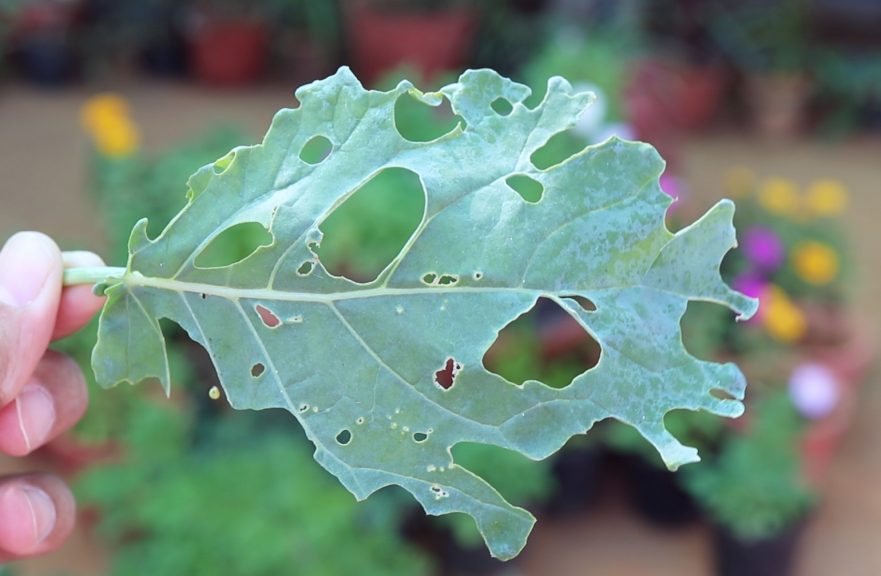
Chewed Leaves or Slime Trails
- Chewed Leaves or Slime Trails: If you seeirregular-shaped holes in the leaf (but not along the edges) and if you seeslime trails or lines, then most likely the Culprits are Slugs and Snails. So Whats the Solution? There are lot ofremedies for slugs and snails but Beer Trap is the most effective oneconsidered by many. Pour some beer in a saucer and leave it overnight. Thisattracts and kills these creatures. Chewed Leaves along the edges: Leafcutting bees are the culprits. So whats the solution? Generally unless its tooextensive damage, you need not take any step to kill or drive away these bees,because they are beneficial insects and required for pollination in yourgarden.
- Chewed Leaves with central holes in betweenveins – like Skeletonised leaves. The culprit here is Caterpillars if largerholes, then the other insects which can cause this pattern are Beetles, Earwigsand Saw flies. So whats the remedy. For caterpillars, hand pick and eliminatethem including their eggs from the leaves. After doing this apply a neem oil +soap solution weekly twice. 10 ml neem oil + 10 drops or 10 ml of liquid soapor shampoo and spray it thoroughly including the undersides of the leaves.
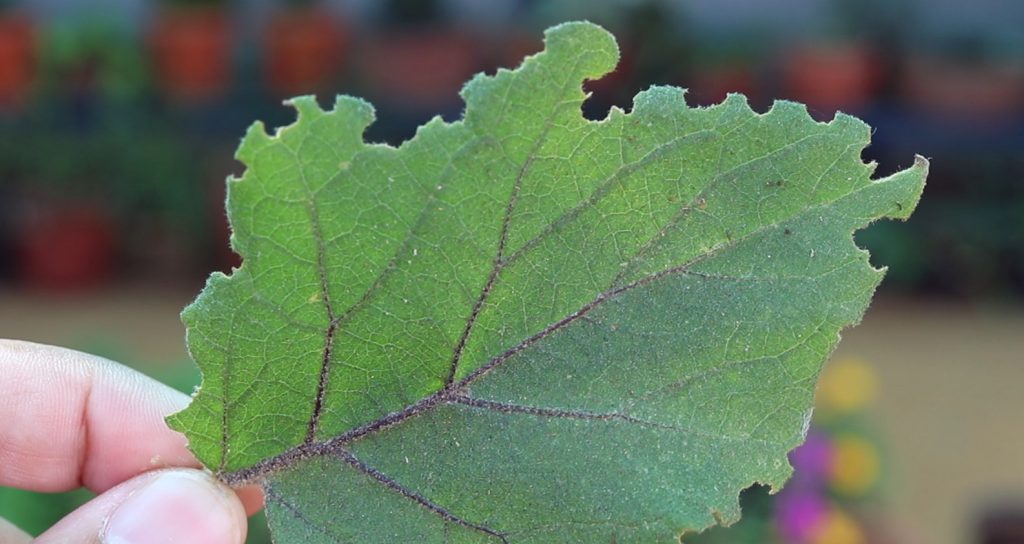
Skeletonised leaves
Discolored Leaves + Sucking Damage: Thisis commonly caused by Thrips and Spider Mites, common thrips are the CubanLaurel Thrips. As you can see here, the leaf is discoloured and then foldedonto itself to form a pouch or cover these creatures and its eggs. If leftuntreated, these thrips will multiply drastically and can cause a considerabledamage to your plant. So Whats thesolution? You can use the same Neem oil + soap spray weekly twice or can addanother oil like clove oil or eucalyptus oil if they are too extensive. If theystill persist, then go for a chemical sprays like those containing Imidaclopridas the last resort. If you still want organic solution like me, consideranother option called diatomaceous earth (DE).
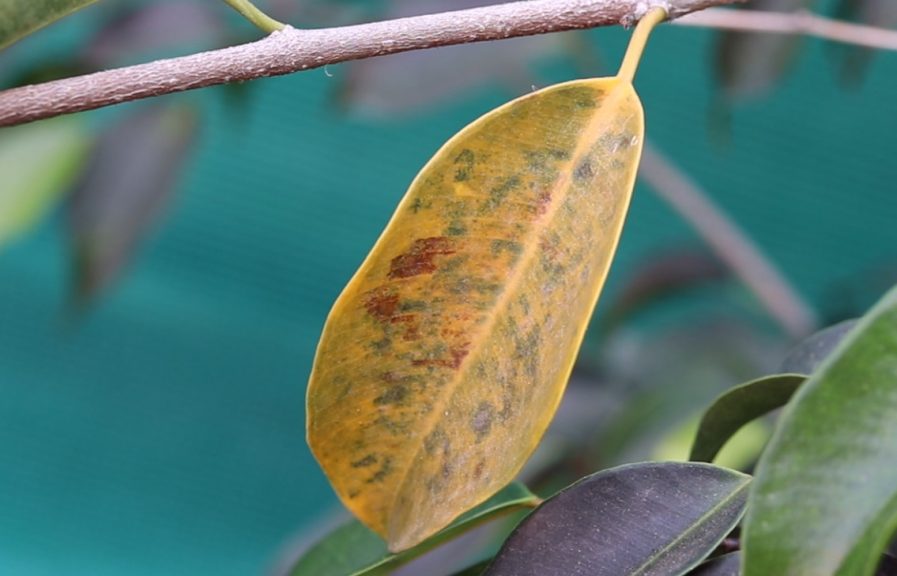
Zig zag leaf mining Pattern: Obviouslythese are called Leaf miners. Leafminers are very tiny larvae of a variety ofinsects like flies, moths and beetles. Leafminers do not actually cause majorinjury to the infested plant, but rather give an unattractive look to theplant. This mining pattern of zig zag lines on the leaves are produced as thesetiny larvae burry and eat along the infested leaves. If you want to control these, Neem oil is thebest solution. You can watch my detailed video on leaf miners and its remediesfrom HERE.
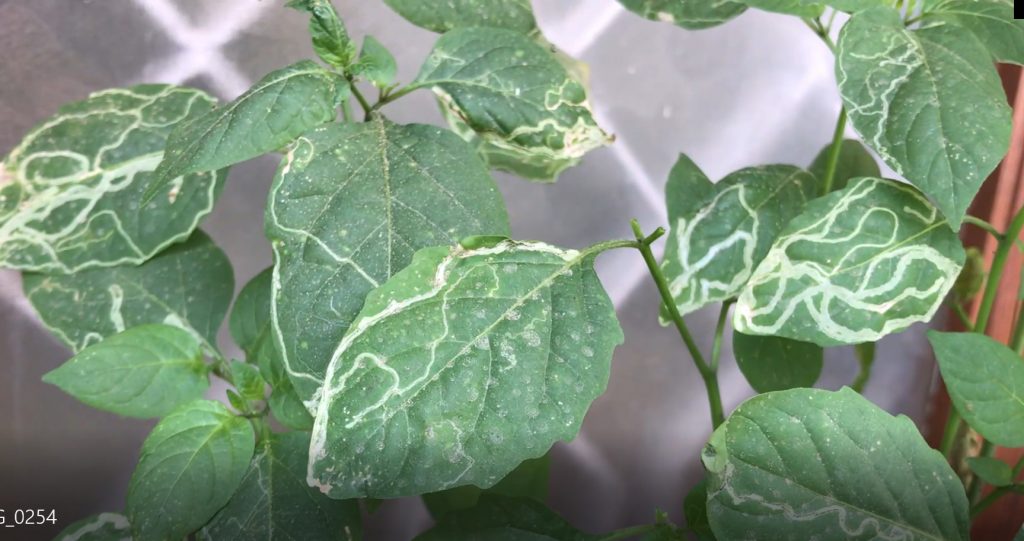
Sucking Damage and Deformed Leaves and Leaf Curls: Common Sucking pests are Aphids,Whiteflies and Mealy Bugs. The mealy bugs are very common and are found suckingthe new growth and tips. Infact, Mealybugs as well as Aphids have a symbioticrelationship with Ants which protect these pests from predators and also carrythem to the plants. The Ants in turn get the honeydew sugars excreted out oftheir anus as their gift. So, Whats the Solution? I have been using theMagic organic mix containing multiple ingredients along with neem oil tocontrol these. But they need a weekly spray with this solution depending on theseverity. There are lot of solutions to these pests including alcohol basedsprays, neem oil and many others. Please check a video on this topic HERE.

Leaf Galls or Leaf Bumps: This is astrange and rare pattern which presents as tumour like boils on the leafsurface. This is considered to be due to irritation or stimulation of plantcells due to feeding or egg-laying by insects such as aphids, wasps and mites.

